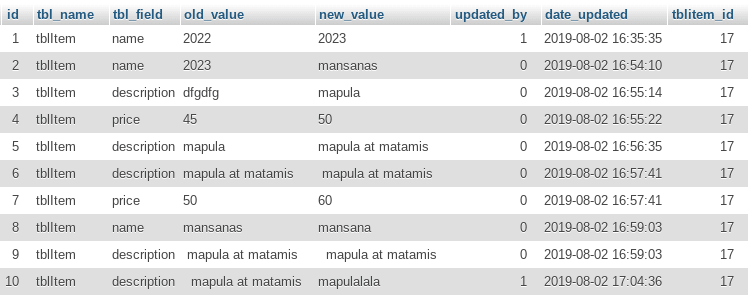Every programmer has had to deal with CRUD functionality in most of their projects specially on applications that utilizes forms to retrieve and return data from a database. Here is a simple app with CRUD functionality. Download or clone the app here
Below is the simple CRUD created:
It’s DB table look like this:
Audit trails are implemented to maintain a record of system activity. This is to keep track of what changes were made to the database, and by whom.
Implementing audit trail may be performed either by program code or database procedures/triggers. We can start by altering the DB table tblitem and add additional fields to implement the trail.
Audit Trail implementation for CREATE
1) Add the fields added_by and date_added to DB table tblitem to capture who added the record and when was the record added.
added_by: int (11), allow NULL, default: NULL
date_added: timestamp, allow NULL, default: NULL
2) Add a trigger to capture the current date & time and update the date_added field with the current timestamp. Name the trigger trigger_on_insert
BEGIN
SET NEW.date_added = CURRENT_TIMESTAMP;
END
3) Modify Item controller global constructor by getting the session data.
4) Add the session data to the Item controller insert() function.
5) Modify the ItemModel insert() function by setting and adding the session data to the insert query
Yeay! We just created an audit trail on who added the record and when was the record added.
Now, test it! Try to add a new record in the CRUD application and check the DB table tblitem if the record was inserted and fields added_by and date_inserted was populated by the session id and current timestamp.
Audit Trail implementation for DELETE
For delete operations, there are several ways to implement the trail depending on the data retention policy of the organization. Some organization do “hard delete” from the DB table and keep and deleted records to another DB table as archived tables.
While other organization do “soft delete” by tagging the record “inactive” or “deleted” or “archived” and not showing it to the record list by filtering only the active records.
Let’s try to do the “soft delete” approach.
1) Add the following fields to tblitem to capture if the record is deleted/inactive/archived, who deleted the record and when was the record deleted.
archived: tinyint (1), allow NULL, default: 0
archived_by: int (11), allow NULL, default: NULL
date_archived: timestamp, allow NULL, default: NULL
2) Add a trigger to capture the current date & time and update the date_archived field with the current timestamp. Name the trigger trigger_on_update
BEGIN
IF NEW.archived = 1 THEN
SET NEW.date_archived = CURRENT_TIMESTAMP;
ELSEIF NEW.archived = 0 THEN
SET NEW.date_archived = NULL;
SET NEW.archived_by = NULL;
END IF;
END IF;
END
3) Update the ItemModel destroy() function by populating the archived and archived_by fields with the archived tag = ‘1’ and session id.
4) In the ItemModel getItems() function, include a WHERE clause limiting the list with active records only.
Yeay! We just created an audit trail on who deleted a record and when was the record deleted.
Now, test it! Try to delete a record in the CRUD application and check the tblitem if the record’s archived field was updated with value ‘1’ and fields archived_by and date_archived was populated by the session id and current timestamp.
At this point, the DB structure of tblitem now look like this:
And added the following triggers:
Audit Trail implementation for UPDATE
1) Create a new DB table audit_trail having the below table structure
2) Update the trigger_on_update at DB table tblitem with the following script:
BEGIN
IF NEW.archived = 1 THEN
SET NEW.date_archived = CURRENT_TIMESTAMP;
ELSEIF NEW.archived = 0 THEN
SET NEW.date_archived = NULL;
SET NEW.archived_by = NULL;
IF NEW.name <> OLD.name THEN
INSERT INTO audit_trail (tbl_name, tbl_field,old_value,new_value,updated_by,date_updated,tblItem_id) VALUES ('tblItem','name',OLD.name,NEW.NAME,NEW.added_by,CURRENT_TIMESTAMP,NEW.id);
END IF;
IF NEW.description <> OLD.description THEN
INSERT INTO audit_trail (tbl_name, tbl_field,old_value,new_value,updated_by,date_updated,tblItem_id) VALUES ('tblItem','description',OLD.description,NEW.description,NEW.added_by,CURRENT_TIMESTAMP,NEW.id);
END IF;
IF NEW.price <> OLD.price THEN
INSERT INTO audit_trail (tbl_name, tbl_field,old_value,new_value,updated_by,date_updated,tblItem_id) VALUES ('tblItem','price',OLD.price,NEW.price,NEW.added_by,CURRENT_TIMESTAMP,NEW.id);
END IF;
END IF;
END
We have implemented an audit trail during record update. We created an audit table that captured what was updated by logging the name of table and field updated, the old and new value of the record, who updated the data, and when was the data updated.
Here is a the DB table audit_trail populated with data after update operation:
And DB table tblitem now looks like this:


















Top comments (0)